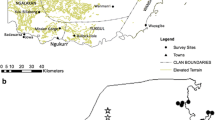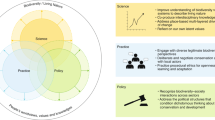Abstract
In a context of globalization, Article 8j. from the Convention on Biological Diversity recognizes the value of biodiversity and formalizes its mixed nature through its biological as well as cultural dimensions. This new definition raises questions more than it solves them. We demonstrate that national and international organizations, local communities, and even researchers from different disciplines (anthropology, botany or genetics) identify and evaluate biodiversity differently. The various stakeholder groups have developed an unavoidable social relation with multiple aspects of biodiversity that they relate to through their job or way of life. And therefore, they pursue various conservation purposes: the preservation of place’s memory through ancestral links, cultural diversity, phenotypic variability or evolutionary potential. Which disciplinary and ethical boundaries are these actors willing to compromise, in order to preserve biodiversity in the name of development? Which indicators should we choose to fulfil which goals? The contrasting examples of taro (a socially valued object, planted on taro pondfields inherited “from the ancestors”, linked to an important cultural diversity and to a narrow genetic-base) and coconut (a socially devalued object, cultivated in coconut plantations at the prompting of “the Whites” and genetically diverse despite few named types) demonstrate that same farmers from a village in Vanuatu (South Pacific) affirm traditional ecological knowledge though their management of taro, and still participate in a market economy by intensifying their crop of coconuts. Conservation and research programs should integrate ethical questions and political processes to reconcile systems of diversified values and representations.
Similar content being viewed by others
Abbreviations
- CBD:
-
Convention on Biological Diversity
- CIRAD:
-
Centre de coopération International en Recherche Agronomique pour le Développement
- FFEM:
-
Fond Français pour l’Environnement Mondial
- IRD:
-
Institut de Recherche pour le Développement.
- IFB:
-
Institut Français de la Biodiversité
References
Alcorn JB, Toledo VM (1998) Resilient resource management in Mexico’s forest ecosystems. In: Berkes F, Folke C (eds) Linking social and ecological systems. Cambridge University Press, Cambridge
Bahuchet S, de Maret P, Grenand F et al (2001) Un regard sur les peuples des forêts tropicales. Editions de l’Université, Bruxelles
Barrau J (1965) Witnesses of the past: note on some food plants of Oceania. Ethnology 4:282–294
Bloch M (1977) The past and the present in the present. Man 12:278–292
Bolton L (1999) Women, place and practice in Vanuatu: a view from Ambae. Oceania 70(1):43–55
Bonnemaison J (1996) Gens de pirogue et gens de la terre. Editions de l’ORSTOM, Paris
Caillon S (2007a) Le cocotier, un indicateur de changement? Etude ethnobotanique dans un village de Vanua Lava (Vanuatu-Mélanésie). Journal d’Agriculture Tropicale et de Botanique Appliquée 47
Caillon S. (2007b) Arbre d’antan, arbre “des Blancs”. Evolution de la valeur sociale des cocotiers et de leur espace à Vanua Lava (Vanuatu). Géographie et Culture 64
Caillon S, Lanouguère-Bruneau V (2005) Gestion de l’agrobiodiversité dans un village de Vanua Lava (Vanuatu): stratégies de sélection et enjeux sociaux. Journal de la Société des Océanistes 120–121(1):129–148
Caillon S, Malau EF (2002) Coconuts and taro from the West Coast of Vanua Lava (Vanuatu): an ethno-agronomic inventory. IRD, Orléans
Caillon S, Quero-García J, Lescure J-P et al (2006) Nature of taro (Colocasia esculenta (L.) Schott) genetic diversity prevalent in a Pacific Ocean island, Vanua Lava, Vanuatu. Genet Resour Crop Evol 53(6):1273–1289
Chartier D (2005) ONG internationales environnementales et politiques forestières tropicales. L’exemple de Greenpeace en Amazonie. Anthropologie et société 29(1):103–120
Clarke WC (1971) Place and people: an ecology of New Guinean community. University of California Press, Berkeley
Codrington R-H (1891) The Melanesians: studies in their anthropology and folklore. Clarendon Press, Oxford
Curtis T (1999) Tom’s Tambu house: spacing, status and sacredness in south Malakula, Vanuatu. Oceania 70(1):56–71
Curtis T (2002) Talking about place, PhD thesis. The Australian National University, Anthropology, Canberra
Descola P (1986) La Nature Domestique: symbolisme et praxis dans l’écologie des Achuar. Edition de la Maison des Sciences de l’Homme, Fondation Singer, Paris
Descola P (2005) Par delà nature et culture. Editions Gallimard, Paris
Descola P, Pálsson G (1996) Nature and society. Anthropological perspectives. Routledge, Londres
Dove MR (1999) The agronomy of memory and the memory of agronomy. Ritual conservation of archaic cultigens in contemporary farming systems. In: Nazarea VD (ed) Ethnoecology. Situated knowledge/located lives. The University of Arizona Press, Tucson
Friedberg C (1992) La question du déterminisme dans les rapports homme-nature. In: Jollivet M (ed) Les passeurs de frontières. Sciences de la nature, Sciences de la société, CNRS Editions, Paris
Friedberg C (1997) Diversité, ordre et unité dans les savoirs populaires. Natures Sciences Sociétés 5(1):5–17
Gadgil M, Henam NS, Reddy M (2002) People, refugia and resilience. In: Berkes F, Folke C (eds) Linking social and ecological systems. Cambridge University Press, Cambridge
Godelier M (1984) L’idéel et le matériel. Pensées, économie, sociétés. Fayard, Paris
Hao S (2005) Taro forum to discuss genetic research. In: The Honolulu Advertise. http://the.honoluluadvertiser.com/. Cited 20 May 2005
Haudricourt AG (1964) Nature et culture dans la civilisation de l’Igname: l’origine des clones et des clans. L’Homme 4(1):93–104
Hays TE (1974) Mauna: explorations in Nbumba ethnobotany. University of Washington, Seattle
Hess S (2005) Person and place on Vanua Lava, Vanuatu, PhD thesis. The Australian National University, Anthropology, Canberra
Lebot V, Hartati S, Hue NN et al (2000) Genetic variation in taro (Colocasia esculenta) in South East Asia and Oceania. In Cultio Corp.: Proceedings of the twelfth symposium of the ISTRC, Tsukuba, Japan
Levang P (2001) Is tenure security/insecurity the determining factor in sustainability of local systems of forest management? In: Michon G (ed) Alternative strategies to forest resource development, FORRESASIA, Rapport final à la Commission européenne
Lévi-Strauss C (2005) Entretien. Le Monde, Paris, 23 February 2005
Michon G (2002) Du discours global aux pratiques locales, ou comment les conventions sur l’environnement affectent la gestion de la forêt tropicale. In: Martin J-Y (ed) Développement durable? Doctrines, pratiques, évaluations. IRD Editions, Paris
Ouhoud-Renoux F (2000) Le cas Palikur: un combat pour une adaptation à des contraintes fortes. In: Grenand P (ed) Les peuples des forêts tropicales aujourd’hui, APFT, FRP, Bruxelles
Panoff F (1972) Maenge gardens. A study of Maenge relationship to domesticates. PhD thesis, The Australian National University, Anthropology and sociology, Canberra
Pinton F (2005) Gestion environnementale en Amazonie brésilienne. Le local redéfini par la tradition. In Biodversité. Science et gouvernance, UNESCO, Paris
Pinton F, Emperaire L (2001) Le manioc en Amazonie brésilienne: diversité et marché. Genet Sel Evol 33:S491–S512
Pujol B, Mühlen G, Garwood N et al (2005) Evolution under domestication: contrasting functional morphology of seedlings in domesticated cassava and its closest wild relatives. New Phytol 166(1):305–318
Quero-García J, Noyer JL, Marchand JL et al (2004) Germplasm stratification of taro (Colocasia esculenta) based on agro-morphological descriptors. Validation by AFLP markers. Euphytica 137:387–395
Rivers WHR (1914) The history of Melanesian society. Cambridge University Press, Cambridge
Rodman M (1987) Masters of tradition: consequences of customary land tenure in Longana, Vanuatu. University of British Colombia Press, Vancouver
Rodman M (1992) Empowering place: multilocality and multivocality. Am Anthropol 94:640–656
Roué M (1998) Anthropologie et environmentalism: pour une mise au point. Natures Sciences Sociétés 6(2):50–54
Speiser F (1990 [1923]) Ethnology of Vanuatu. An early twentieth century study. Crawford House Press, Bathurst, Australia
Takacs D (1996) Idea of biodiversity, philosophies of paradise. John Hopkins University Press, Baltimore and London
Taylor JP (2003) The ways of the place: history, cosmology and material culture in North Pentecost, Vanuatu. PhD thesis, The Australian National University, Anthropology, Canberra
Theodoropoulos D (2006) Germplasm news and views. Society for Economic Botany Newsletter 20:7
Vienne B (1984) Gens de Motlav. Idéologie et pratique sociale en Mélanésie. Société des Océanistes, Musée de l’Homme, Paris
Acknowledgements
The authors would like to thank all villagers from Vêtuboso––especially Chiefs Eli Field Malau and Hosea Waras––the geneticists José Quero-García for the taro, and Patricia Lebrun and Angélique Berger for the coconut, without whom this work could not have reached such an interdisciplinary width. We thank the anonymous reviewer for his/she comments on earlier draft of this paper. We are also grateful to the French Institute of Biodiversity (IFB) that allowed us to examine our ideas on biodiversity in the framework of the “Young-Researchers” competition organized in 2004. The project “conservation of coconut-taro in Vanuatu” (2001–2003) was financed by the Région Centre, CIRAD and IRD.
Author information
Authors and Affiliations
Corresponding author
Rights and permissions
About this article
Cite this article
Caillon, S., Degeorges, P. Biodiversity: negotiating the border between nature and culture. Biodivers Conserv 16, 2919–2931 (2007). https://doi.org/10.1007/s10531-007-9149-7
Received:
Accepted:
Published:
Issue Date:
DOI: https://doi.org/10.1007/s10531-007-9149-7




